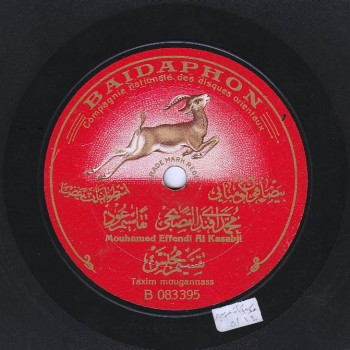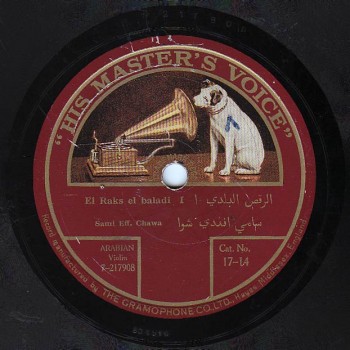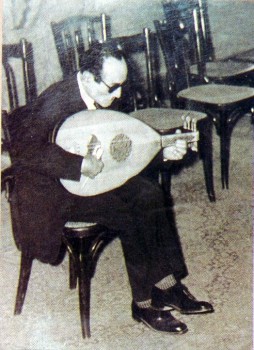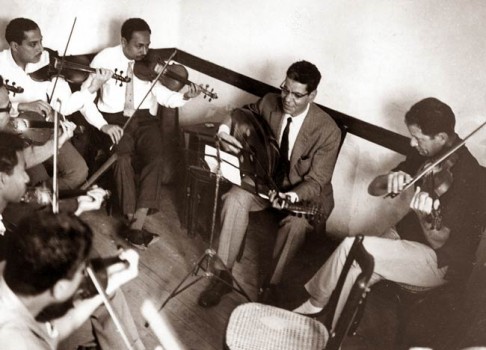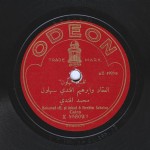The Arab Music Archiving and Research foundation (AMAR), in collaboration with the Sharjah Art Foundation (SAF), presents “Niẓāmunā al-Mūsīqī”.
Dear listeners,
Welcome to a new episode of “Niẓāmunā al-Mūsīqī”.
Today, we will resume our discussion about the taqsīm and its different types.
The other 4-pulse’ rhythms the instrumentalists played taqsīm to include the maqsūm and the shaftah tallī or zaffa, which taqsīm they named raqṣ baladī, or raqṣ miṣrī or raqṣ ghazzāwī..etc. In fact, this was not a musical piece, but a more or less fast segmentation to this rhythmic beat.
As an example, let us listen to a taqsīm baladī to the maqsūm performed by Sāmī al-Shawwā who named it raqṣ baladī, recorded around 1924 by His Master’s Voice on one side of a 25cm record, # 7-217908, matrix # BD 4510, accompanied by Manṣūr ‘Awaḍ…
(♩)
Let us listen to another recording of Sāmī al-Shawwā: a taqsīm to the 3-pulse’ dārij rhythm whose structure is close to the baḥr ramal’s, made in the U.S.A on a 33rpm record among the recordings of Sāmī al-Shawwā made there between 1953 and 1955…
(♩)
There are other types of taqsīm known under both the mursal and the muwaqqa‘ forms, such as the taqsīm mujannas –a taqsīm that starts to a certain maqām and ends to another maqām. This type was apparently used in the melodic transition from one waṣla to another when the instrumentalists chose not to break between the waṣla.
As an example, let us listen to a taqsīm mujannas performed by Muḥammad al-Qaṣṣabjī –one of the major composers of his generation who recorded many solo ‘ūd instrumental records– recorded around 1923 by Baidaphon on one side of a 27cm record # B-083395…
(♩)
Numerous episodes won’t be enough to discuss all the types of taqsīm. Yet, as very few specialized in taqsīm, we chose to highlight the most famous forms only.
We end today’s episode with a type mixing the mursal and the muwaqqa‘ to a cyclic rhythm: the instrumentalist performs taqsīm mursal, then taqsīm muwaqqa‘ to a cyclic rhythm, then goes back to the mursal etc, at whim.
As an example, let us listen to a taqsīm to the bayyātī performed by Riyāḍ al-Sunbāṭī mixing mursal and bamb, recorded within the same publication of Ṣawt al-Qāhira mentioned previously dedicated to Riyāḍ al-Sunbāṭī…
(♩)
Dear listeners, we have reached the end of today’s episode of “Niẓāmunā al-Mūsīqī”.
We will meet again in a new episode.
“Niẓāmunā al-Mūsīqī” is brought to you by Mustafa Said.
- 221 – Zakariyya Ahmed – 12 (1/9/2022)
- 220 – Zakariyya Ahmed – 11 (1/9/2022)
- 219 – Zakariyya Ahmed – 10 (11/25/2021)
- 218 – Zakariyya Ahmed – 9 (10/26/2021)
- 217 – Zakariyya Ahmed – 8 (9/24/2021)
- 216 – Zakariyya Ahmed – 7 (9/4/2021)
- 215 – Zakariyya Ahmed – 6 (8/28/2021)
- 214 – Zakariyya Ahmed – 5 (8/6/2021)
- 213 – Zakariyya Ahmed – 4 (6/26/2021)
- 212 – Zakariyya Ahmed – 3 (5/27/2021)
- 211 – Zakariyya Ahmed – 2 (5/1/2021)
- 210 – Zakariyya Ahmed – 1 (4/28/2021)
- 209 – W-al-Lāhi lā astaṭī‘u ṣaddak 2 (4/6/2017)
- 208 – W-al-Lāhi lā astaṭī‘u ṣaddak 1 (3/30/2017)
- 207 – Bashraf qarah baṭāq 7 (3/23/2017)

